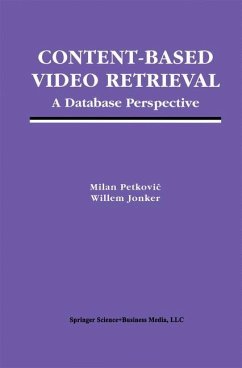This book focuses particularly on content-based video retrieval. After addressing basic concepts and techniques in the field, Content-Based Video Retrieval: A Database Perspective concentrates on the semantic gap problem, i.e., the problem of inferring semantics from raw video data, as the main problem of content-based video retrieval. This book identifies and proposes the integrated use of three different techniques to bridge the semantic gap, namely, spatio-temporal formalization methods, hidden Markov models, and dynamic Bayesian networks. As the problem is approached from a database perspective, the emphasis evolves from a database management system into a video database management system. This system allows a user to retrieve the desired video sequence among voluminous amounts of video data in an efficient and semantically meaningful way. This book also presents a modeling framework and a prototype of a content-based video management system that integrates the three methods and provides efficient, flexible, and scalable content-based video retrieval. The proposed approach is validated in the domain of sport videos for which some experimental results are presented.
The area of content-based video retrieval is a very hot area both for research and for commercial applications. In order to design effective video databases for applications such as digital libraries, video production, and a variety of Internet applications, there is a great need to develop effective techniques for content-based video retrieval. One of the main issues in this area of research is how to bridge the semantic gap between low-Ievel features extracted from a video (such as color, texture, shape, motion, and others) and semantics that describe video concept on a higher level. In this book, Dr. Milan Petkovi6 and Prof. Dr. Willem Jonker have addressed this issue by developing and describing several innovative techniques to bridge the semantic gap. The main contribution of their research, which is the core of the book, is the development of three techniques for bridging the semantic gap: (1) a technique that uses the spatio-temporal extension of the Cobra framework, (2) atechnique based on hidden Markov models, and (3) a technique based on Bayesian belief networks. To evaluate performance of these techniques, the authors have conducted a number of experiments using real video data. The book also discusses domains solutions versus general solution of the problem. Petkovi6 and Jonker proposed a solution that allows a system to be applied in multiple domains with minimal adjustments. They also designed and described a prototype video database management system, which is based on techniques they proposed in the book.
The area of content-based video retrieval is a very hot area both for research and for commercial applications. In order to design effective video databases for applications such as digital libraries, video production, and a variety of Internet applications, there is a great need to develop effective techniques for content-based video retrieval. One of the main issues in this area of research is how to bridge the semantic gap between low-Ievel features extracted from a video (such as color, texture, shape, motion, and others) and semantics that describe video concept on a higher level. In this book, Dr. Milan Petkovi6 and Prof. Dr. Willem Jonker have addressed this issue by developing and describing several innovative techniques to bridge the semantic gap. The main contribution of their research, which is the core of the book, is the development of three techniques for bridging the semantic gap: (1) a technique that uses the spatio-temporal extension of the Cobra framework, (2) atechnique based on hidden Markov models, and (3) a technique based on Bayesian belief networks. To evaluate performance of these techniques, the authors have conducted a number of experiments using real video data. The book also discusses domains solutions versus general solution of the problem. Petkovi6 and Jonker proposed a solution that allows a system to be applied in multiple domains with minimal adjustments. They also designed and described a prototype video database management system, which is based on techniques they proposed in the book.








